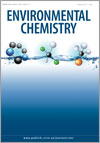
Environmental Chemistry
Volume 8 Number 5 2011
GEOSPEC 2010
EN11031 How well can we predict and measure metal speciation in freshwaters?
The ‘speciation’ of metals is concerned with their different chemical and physical forms, a detailed knowledge of which is essential to understand what happens to metals in lakes and rivers, and their effects on living organisms. There have been many advances in recent years in our ability both to measure and predict metal speciation in natural waters, but it is not clear just how accurately these can be applied under field conditions. The current state of play is assessed to provide a better understanding of the related uncertainties, and suggestions are made for ways to reduce these uncertainties and possibly improve our predictive capabilities.
EN11021 Strategies in the application of the Donnan membrane technique
Free ion concentrations determine the effects of nutrients and pollutants on organisms in the environment. The Donnan membrane technique provides a measure of free ion concentrations. This paper presents clear guidelines on the application of the Donnan membrane technique for determining free ion concentrations in both synthetic and natural samples.
EN11023 Determination of manganese and zinc in coastal waters by anodic stripping voltammetry with a vibrating gold microwire electrode
Metals in the marine environment play a role in biological processes but can also be toxic. An electrochemical method with a simple microwire electrode is presented that facilitates detection of zinc and manganese in coastal waters. The method is very sensitive and will likely lead to the development of an in-situ monitoring apparatus.
EN11025 Modelling lead(II) sorption to ferrihydrite and soil organic matter
Lead(II) is a toxic metal pollutant with many anthropogenic sources. We show that lead(II) is bound more strongly to soil surfaces than previously understood. This knowledge may lead to better models for lead(II) dissolution from the soils, which will improve risk assessments for this metal.
EN11020 Fractionation of lead in soil by isotopic dilution and sequential extraction
The chemical reactivity of lead in soil is difficult to assess and depends on both soil conditions and the origins of the lead. This paper tests the combined application of lead isotopic techniques and chemical extraction against our understanding of lead fractionation in soils. Possibly against expectation, it appears that the ‘reactivity’ of lead can be high and yet there is tentative evidence that the original source of the metal affects its fractionation in soil, even after long contact times.
EN11049 Assessing WHAM/Model VII against field measurements of free metal ion concentrations: model performance and the role of uncertainty in parameters and inputs
The chemical speciation of metals in waters is of great importance in determining their transport, fate and effects in the environment. Modelling chemical speciation is valuable for making predictions about these effects. Here a model of metal speciation is tested against field data, and recommendations are made as to how both model and measurements might be improved in future.
EN11046 Using diffusive gradients in thin films to probe the kinetics of metal interaction with algal exudates
Interaction of metals with dissolved organic matter is one of the key processes defining metal bioavailability in water. The technique of diffusive gradients in thin films was used to investigate the kinetics of the interaction between metals and dissolved organic matter released by algae. For most metals the rate at which they were released from the organic matter was fast, but release of iron was kinetically limited.
EN11022 Steady-state DGT fluxes of nanoparticulate metal complexes
Diffusive gel layer techniques can measure fluxes of chemical species in aqueous environmental media. Nanoparticulate metal complexes are small enough to penetrate gels, but their diffusive response is much slower than that of the free metal ions. Hence, time-resolved analysis of the diffusive flux of the complex sample is proposed as a chemical speciation tool for the nanodomain.



